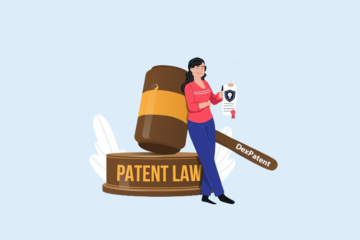8 Steps to Perform a Patent Invalidity Search Yourself

As innovation accelerates, patents play an increasingly critical role in safeguarding intellectual property and commercializing novel concepts. Conducting a patent validity or invalidity search can be a game-changer in the face of patent infringement or when seeking to gain a competitive advantage in a crowded market.
In this blog post, we will guide you through the process of conducting a patent invalidity search. We will provide step-by-step instructions for performing a patent invalidity search on your own. By the end of this post, you will have the knowledge to challenge the validity of a patent, protect your own intellectual property, and unlock new opportunities for innovation. If you’re ready to take control of your patent landscape, challenge the validity of patents, and contribute to a more open and dynamic economy, keep reading!
8 steps to perform a patent invalidity search

Step 1: Understand the claims to be invalidated
Claims are one of the most important parts of a patent application as they define the scope of protection that the patent owner is seeking. Hence, it is important to fully understand the technical and patent issues, and interpret the allowed claims broadly to find relevant art. A detailed reading of file wrapper and prosecution history is recommended for clear interpretation of the claim(s) that need to be invalidated.
Step 2: Consider the priority date of the claims to be invalidated
The priority date is again an important factor to consider when attempting to invalidate a patent. If someone wishes to challenge the validity of a patent, they must demonstrate that the claimed invention was already known or obvious at the time the patent application was filed, or that the claims are not sufficiently clear and complete to meet the enablement requirement.
Step 3: Identify relevant keywords and classifications
As you read through the patent claims to be invalidated, identify the key elements that make up the invention. Based on the key elements you’ve identified, generate a list of keywords that can be used to search for relevant prior art. This may include synonyms, abbreviations, or variations on the key terms. Identifying the patent classification can help identify other patents that are in the same technical field.
You can also review the prosecution history, to identify additional keywords and classes that may be relevant to your search.
Step 4: Perform a broad search
Perform a broad search based on the initially collected keywords and classifications to identify the relevant prior art. Conducting an initial broad search is useful for getting an idea of how many potential prior art references are out there, and for determining the amount of time that may be required for the search.
Once the most commonly used keywords have been identified from the references generated from the initial broad search, these can be saved as part of a collection of synonyms that can be used for future searches.
Step 5: Conduct an exhaustive search
Perform a thorough search in patent databases to identify prior art before the priority date of the claimed subject matter. There are many paid and free databases available for patent search, including Orbit, Total Patent, PatBase, Derwent, Google Patents, USPTO, Espacenet, WIPO and many more.
Patent file wrapper contains important information about the patent, including any rejections, applicant arguments, claim amendments and notice of allowance. Analysing this information can help you identify potential weaknesses in the patent and identify relevant prior art.
During the exhaustive search your strategy should include keywords and classifications identified during your initial broad search. Performing keyword search, classification search and combination of keyword and classification search helps you in identifying relevant prior art. Further, you can perform citation search, targeted assignee search, inventor search, similarity search and semantic search to locate the relevant prior art.
Step 6: Perform non-patent literature search
In addition to patent databases, search on the internet for non-patent literatures such as scientific journals, conference proceedings, technical reports, blogs, videos, images or any news to identify any relevant prior art.
The non-patent search may further be performed on various databases such as Google scholar, IEEE, Science Direct, and Springerlink.
Step 7: Analyze the retrieved results
Once you have identified potential prior art references, focus on those that are most relevant to the patent claims. This can involve analysing the similarities and differences between the prior art and the patent claims, as well as considering any arguments made by the patent holder during prosecution. A precise analysis of the search result is executed to report relevant references that were not cited during the prosecution of the patent.
Step 8: Report the findings
Prepare a claim chart that compares the claimed aspects with identified prior art. This enables you to determine whether the prior art invalidates the patent in question and to make better decisions.
In conclusion, conducting an invalidity search is a crucial step for anyone seeking to challenge the validity of an existing patent. An invalidity search involves a thorough examination of relevant prior art to identify any references that may render the patent invalid.
By conducting an invalidity search, one can potentially save significant time and resources by avoiding costly litigation or licensing fees. The search also provides valuable insights, potential strengths and weaknesses of the existing patent.
However, conducting an invalidity search can be a complex and time-consuming process, and it is crucial to engage an experienced search professional who can effectively identify and analyse the relevant prior art. With the right approach and the right team, an invalidity search can be a powerful tool for protecting intellectual property rights and promoting innovation.
DexPatent’s approach to invalidity search
IP service providers can be invaluable when it comes to conducting a patent invalidity search. IP providers have access to extensive databases and advanced search technologies that can help to identify prior art that may not be easily discoverable through traditional means. Furthermore, IP service providers typically engage skilled searchers who possess expertise in patent law and are familiar with the complexities of patent searching. They can analyse patent claims and other relevant documents to develop a search strategy that is tailored to the specific needs of a client.
In addition to conducting a thorough search, IP service providers can also provide customized reports that help clients understand the results of the search and make informed decisions about their patent strategy. These reports may include analysis of the identified prior art, as well as recommendations for how to proceed in light of the search results. By working with an IP service provider, you can save time and resources, while also benefiting from the expertise and experience of professionals who are dedicated to protecting their intellectual property.
We, DexPatent always follow a comprehensive and systematic approach to invalidity searches. We start by analysing the patent claims, description, file wrapper, patent family, prior litigation, and prosecution history to identify potential weaknesses that can be targeted. In addition, we leverage industry-leading databases and cutting-edge technological tools to perform extensive and thorough searches for both patent and non-patent literature.
As part of our search process, we utilize supplementary strategies that may not have been included in the examiner’s search methods to identify any potentially relevant prior art. We develop a more targeted search approach by analysing claim interpretation and previous arguments.
After completing the search, we deliver detailed reports based on customer requirements to provide precise, cost-effective, and timely results.












0 Comments